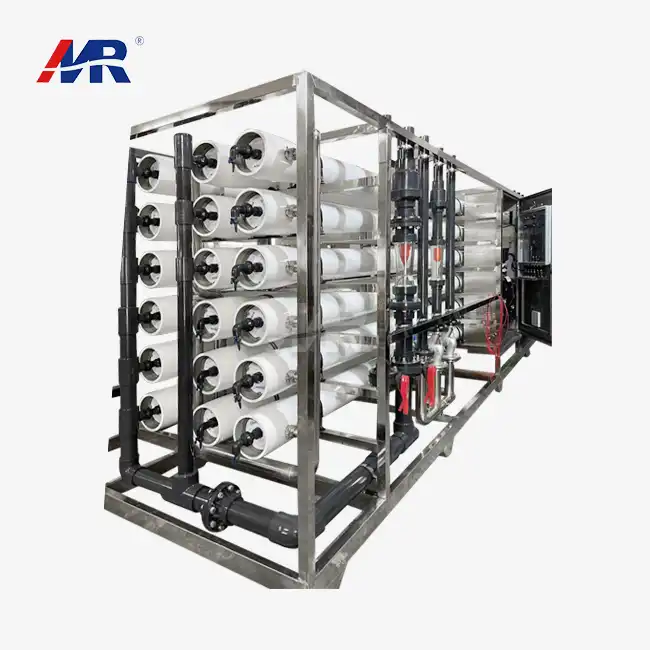How biofilm growth damages reverse osmosis membranes
Biofilm formation is a significant concern for operators of reverse osmosis systems. These slimy, microbial communities can wreak havoc on RO membranes, leading to a cascade of problems that impact system performance and water quality.
The process of biofilm development
Biofilms begin to form when microorganisms adhere to the membrane surface. Over time, these microbes multiply and secrete extracellular polymeric substances (EPS), creating a protective matrix that allows the colony to thrive. As the biofilm matures, it becomes increasingly resistant to chemical treatments and physical removal.
Impact on membrane performance
The presence of biofilms on RO membranes can have several detrimental effects:
- Reduced flux: Biofilms create a barrier that impedes water flow through the membrane, decreasing the system's overall productivity.
- Increased pressure drop: As biofilms accumulate, more pressure is required to push water through the membrane, leading to higher energy consumption.
- Membrane degradation: Some microorganisms produce enzymes that can break down the membrane material, shortening its lifespan.
- Contamination: Biofilms can harbor pathogens and release them into the permeate, compromising water quality.
Long-term consequences
If left unchecked, biofilm growth can lead to irreversible membrane damage, necessitating premature replacement of costly RO elements. This not only increases operational expenses but also results in significant downtime for the BWRO plant. Regular sanitization is crucial to prevent these issues and maintain the integrity of the RO system.
Chemical vs. thermal sanitization for RO systems
When it comes to sanitizing reverse osmosis equipment, operators have two primary options: chemical and thermal sanitization. Each method has its advantages and considerations, and the choice often depends on the specific requirements of the RO plant and the industry it serves.
Chemical sanitization methods
Chemical sanitization involves the use of various disinfectants to eliminate microorganisms and remove biofilms from RO membranes and associated equipment. Common chemicals used include:
- Chlorine-based compounds: Effective against a wide range of microorganisms but can damage certain membrane types if not used carefully.
- Peracetic acid: A potent sanitizer that breaks down into harmless byproducts, making it environmentally friendly.
- Hydrogen peroxide: Often used in combination with other chemicals for enhanced efficacy.
- Formaldehyde: Highly effective but requires careful handling due to health and safety concerns.
Chemical sanitization is often preferred for its ability to target specific types of fouling and its effectiveness at ambient temperatures. However, it requires careful dosing and monitoring to prevent membrane damage and ensure complete removal of chemicals post-treatment.
Thermal sanitization techniques
Thermal sanitization relies on high temperatures to inactivate microorganisms and disrupt biofilms. This method typically involves circulating hot water (usually 80°C or higher) through the reverse osmosis system for a specified period. Advantages of thermal sanitization include:
- No chemical residues: Eliminates concerns about chemical contamination of the final product.
- Effective against a broad spectrum of microorganisms: Heat can penetrate biofilms and reach areas that chemicals might miss.
- Simplicity: Often easier to implement and control compared to chemical treatments.
However, thermal sanitization can be energy-intensive and may not be suitable for all membrane types. It also requires careful temperature control to prevent damage to heat-sensitive components of the RO system.
Choosing the right approach
The decision between chemical and thermal sanitization should consider factors such as:
- Membrane material compatibility
- Type and extent of fouling
- Regulatory requirements
- Energy costs
- System downtime
- Environmental impact
Many facilities opt for a combination of both methods, using chemical sanitization for routine maintenance and thermal sanitization for periodic deep cleaning. This dual approach can provide comprehensive protection against biofilm formation and ensure optimal performance of the reverse osmosis plant.
Frequency of sanitizing industrial reverse osmosis plants
Determining the appropriate frequency for sanitizing industrial RO systems is crucial for maintaining water quality, preserving membrane life, and optimizing operational efficiency. While there's no one-size-fits-all approach, several factors influence the sanitization schedule for a reverse osmosis plant.
Factors affecting sanitization frequency
The following elements play a role in determining how often an RO system should be sanitized:
- Feed water quality: Systems processing water with higher organic content or microbial load may require more frequent sanitization.
- Production demands: Plants operating continuously or at high capacity may need more regular cleaning cycles.
- Industry standards: Certain sectors, such as pharmaceuticals or food production, may have specific regulatory requirements for sanitization intervals.
- System performance indicators: Changes in parameters like differential pressure, salt passage, or permeate quality can signal the need for sanitization.
- Membrane type: Some membranes are more fouling-resistant than others, potentially allowing for longer intervals between sanitizations.
Typical sanitization schedules
While schedules can vary widely, here are some general guidelines for industrial RO plant sanitization:
- Routine sanitization: Many facilities perform a light sanitization every 3-6 months to prevent biofilm establishment.
- Comprehensive cleaning: A more thorough sanitization, often involving both chemical and thermal methods, may be conducted annually or semi-annually.
- Performance-based cleaning: Some operators initiate sanitization when system performance declines by a predetermined percentage, typically 10-15% from baseline.
- Continuous sanitization: In some cases, low-level continuous chlorination or other sanitization methods may be employed to suppress microbial growth constantly.
Optimizing sanitization frequency
To determine the ideal sanitization schedule for a specific RO system, operators should:
- Monitor key performance indicators regularly
- Analyze feed water quality and its variations over time
- Keep detailed records of sanitization procedures and their effects
- Consult with membrane manufacturers and water treatment experts
- Consider implementing early warning systems to detect fouling before it significantly impacts performance
By tailoring the sanitization frequency to the specific needs of the reverse osmosis plant, operators can strike a balance between maintaining optimal performance and minimizing downtime and operational costs.
Conclusion
Regular sanitization is a critical aspect of maintaining the efficiency and longevity of reverse osmosis equipment. By understanding the importance of preventing biofilm growth, choosing appropriate sanitization methods, and optimizing cleaning frequencies, operators can ensure their RO systems continue to produce high-quality water while minimizing operational disruptions and costs.
Are you looking to optimize your reverse osmosis plant's performance through effective sanitization? Guangdong Morui Environmental Technology Co., Ltd is here to help. As specialists in water treatment, we offer comprehensive solutions for industrial wastewater, domestic sewage treatment, seawater desalination, and drinking water manufacturing. Our expertise extends to providing top-quality equipment, seamless installation and commissioning services, essential consumables, and robust after-sales support.
With our state-of-the-art 60m³/hour reverse osmosis plants, we cater to diverse industries, from food and beverage production to pharmaceutical manufacturing and municipal water treatment. Our innovative RO systems are designed to meet the most demanding water purification needs while ensuring reliability, efficiency, and customizability.
Don't let biofilm compromise your water quality. Contact us today at benson@guangdongmorui.com to learn how our advanced reverse osmosis solutions and expert sanitization strategies can elevate your water treatment processes. Let Guangdong Morui be your partner in achieving pristine water quality and operational excellence.
References
1. Johnson, A. R., & Smith, B. T. (2018). Biofilm formation and control in reverse osmosis systems. Journal of Membrane Science, 542, 18-27.
2. Lee, C., & Robinson, D. (2019). Comparison of chemical and thermal sanitization methods for industrial RO plants. Desalination, 460, 32-41.
3. Garcia-Molina, V., et al. (2020). Optimizing sanitization frequency in large-scale reverse osmosis facilities. Water Research, 175, 115683.
4. Patel, R. M., & Thompson, K. L. (2017). Advanced techniques for RO membrane cleaning and sanitization. Industrial Water Treatment, 49(3), 12-18.
5. Nguyen, T., & Anderson, L. (2021). Long-term effects of sanitization practices on reverse osmosis membrane performance. Separation and Purification Technology, 258, 118021.
6. Zhou, H., & Wilkinson, S. (2022). Emerging trends in reverse osmosis plant maintenance and sanitization. Water Science and Technology, 85(5), 1203-1215.

_1745823981883.webp)


